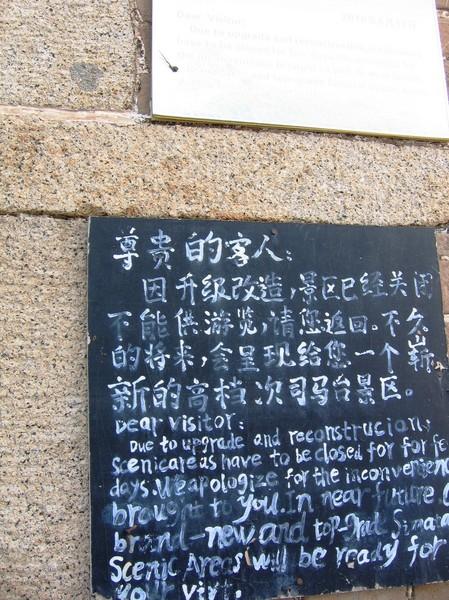
Simatai will remain closed
for hiking
It has been brought to our attention that some tour
companies and travel books are claiming that the Simatai Great Wall is
still open for hiking. However, in order to avoid any disappointment or
wasted money and time, please be advised that THE SIMATAI GREAT
WALL HAS BEEN PERMANENTLY CLOSED TO HIKERS, AND ANY ORGANIZATIONS
CLAIMING OTHERWISE ARE DELIBERATELY MISLEADING YOU. We are
posting this because we want you to know the whole truth, that way you
can make an informed decision on your travel plans based on all of the
available information. Thank you for your continued patience and
understanding!
Simatai section of the Great Wall is closed for renovation
from June 17, 2010. This is a very short notice from Miyun Government and Simatai Authority regarding the repair and renovation.
Recently, from our internal source with the company who has been doing
construction in Simatai, we were told the Simatai Section of the Great
Wall will reopen in October 2014. However, we found from our
inspection that Simatai will get closed from being accessible from
Jinshanling. Our hiking cannot be resumed. And, opening only 10
watch tower is meaningless for a hike and you will NOT experience what
Simatai should be experienced at all. Simatai Authority regarding the repair and renovation.
Recently, from our internal source with the company who has been doing
construction in Simatai, we were told the Simatai Section of the Great
Wall will reopen in October 2014. However, we found from our
inspection that Simatai will get closed from being accessible from
Jinshanling. Our hiking cannot be resumed. And, opening only 10
watch tower is meaningless for a hike and you will NOT experience what
Simatai should be experienced at all.
June 13, 2014 Update
Unfortunately, we are sad to report that the
Simatai
Section of the Great Wall will not be fully accessible from Jinshanling,
from where many people have hiked. The re-development of Simatai as a "watertown"
means that no one will be able to hike from Jinshanling to Simatai, and
that visits to Jinsahnling and Simatai must be conducted separately. As
of now, we are unsure of when the new Simatai will open, but when it
does we will be leading tour and excursions there. And as always, you
can still hike with us at Jinshanling and from the Gubeikou Great Wall
to the Jinshanling Great Wall. We thank you for continued patience and
understanding in dealing with the Simatai closure!
March 25, 2014 Update
We have some unfortunate news in regards to the Simatai Great Wall.
It seems the developer in charge of renovating Simatai has instead
purchased the Simatai property only to focus on building a
Suzhou-style watertown called "Gubei Watertown". While building this
watertown, the developer has neglected in doing much for Simatai,
and as of now, 10 watchtowers of the Simatai Great Wall are open to
the public. We asked the developer's spokesman about any future
Simatai openings, and the spokesman replied that they had no idea
about any future openings.
March 1, 2014 Update
According to the latest whispers, Simatai will continue
to be isolated from Jinshanling for the foreseeable future. The reason
is that developers working on Simatai wish to turn it into a convention
and commercial center with a “watertown”-style theme. To protect their
investment the developers of the Simatai project continue to block
access from Jinshanling, so that they will be the only ones able to
charge for admission.
Some small and improperly licensed agents may try to
sneak customers intoSimatai from an unofficial "backdoor" at
Jinshanling and claim that you are allowed to hike through. This is both
incredibly risky and also illegal. If you are caught, you'll either be
fined or reported to the police. Second, most try to sneak into Simatai
at night. Once dark, this piece of Great Wall is incredibly dangerous to
hike, and if you are hurt or injured there will be no one to help or
assist you.
What this means for you is that you will be unable to
cross over into Simatai from Jinshanling. In the future, when Siamatai
is officially reopened (the opening date is still just a rumor at this
point), we should be able to open a special route to visit Simatai only.
However, we will still be running our modified
Jinshanling and Gubeikou
programs programs to make up for the loss of access to Siamatai, so
you’ll still get the same Great Wall bang for your buck. For more
updates on our Simatai programs please continue to check back at this
space. We thank you for your patience and understanding!
October 28, 2013 Update:
According to our inside sources, the Simatai portion of the Great Wall
is due to open on October
28.
Yes, it was opened on the 28th. However, it got
shut down just in a couple of days.
We were told this section will officially reopen on May 1, 2014.
This means that once again we
will have to wait until May 2014 to offer our most famous and popular
Great Wall program, the Jinshanling-Simatai hike, as well as a whole
assortment of Simatai-related Great Wall treks. We have also heard that the entrance ticket to Simatai will
be 280RMB (about $45), while this price may seem high, we are still
working to confirm if this is indeed the truth. Please look back to this
space for more news and updates on the Simatai Great Wall reopening.
As you may well be aware, many government projects in China are
secretive and information is not readily available to the public,
leading us only to hypothesize based on the scraps and bits of
information we have received. The Simatai project has been done to meet
the interest of certain interest groups, and not to the greater public
at large. The Simatai project was undertaken not for the improvement of
visitors like yourself, but for a better atmosphere for conferences and
conventions (which is why a 5-star hotel has been recently built near
there). There has been no public announcement about the official
re-opening date as of yet, nor do we know what the entrance price for
the re-opened Simatai will be. However, once we learn of the official
re-opening date, we will be sure to let you all know, and we'll get
hiking and trekking tours to Simatai as soon as it is humanly possible.
We thank you for your understanding and cooperation!
TOUR 1A: Jinshanling to Simatai.
One-day hiking tour. (Open to register now!)
TOUR 2A: Gubeikou to
Jinshanling, and
Jinshanling to Simatai. Two-day overnight hiking tour.
The Simatai Great Wall
has been closed for close to two years, but our sources tell us that
Simatai may reopen in October 1, 2013. Please keep in mind that this is
an educated guess on our sources part, and may not be accurate. As you
are surely aware, China’s system of government is very different from
those in Western countries. There is no public debate about construction
projects, and there are no public announcements regarding them. Those
that make the key decisions are done so by the few who are in power. The
ones that decide to undertake these construction projects do not have
anyone consult them on the pros and cons, and often initiate these
projects in the expectation that it will increase their own personal
wealth.
While there are just rumors floating around, we
hear that the new Simatai Great Wall will feature a five-star hotel, a
horse racing track, and a Suzhou
or Zhouzhuang (Suzhou's
suburb)-style canal town called Gubeishui (Gubei Watertown).
Great Wall Adventure Club will keep updating the
progress of Simatai construction and post on this page! Please bookmark
this page!
However do not despair, because we will continue to
take you on outstanding hikes on nearby Great Wall sections like
Jinshanling,
Gubeikou, Jiankou, and
Huanghuacheng. These incredibly
photogenic sections of Great Wall are a great spot for a Great Wall
hike, and are suitable for most ages. As Simatai is closed for
construction, the hike from Jiankou to Mutianyu
has grown in popularity, and encompasses many things you would see on
the Jinshanling-Simatai hike. Like Jinshanling-Simatai, Jiankou-Mutianyu
combines rugged and unrestored Great Wall with classically restored
brickwork and watchtowers. If you were looking to hike
Jinshanling-Simatai, Jiankou-Mutianyu would be a seamless substitute.
The following is about Simatai:
The Simatai section of the Great Wall is situated
at Gubeikou, 120 kilometers northeast of Beijing. First built in 1368
during the reign of Emperor Hongwu of the Ming dynasty (1368-1644), it
is one of the best-preserved sections of Ming Dynasty Great Wall. An
incredible section characterized by delicate and unique designs and
diversified structures, it incorporates a variety of styles from the
other parts of the Great Wall and is thus reputed as a verifiable
“Museum of the Great Wall.”
Zigzagging along steep mountain ranges, this
section of the Great Wall features precipitous areas, which is reflected
by the name of its two parts – the Heavenly Stairway and the Heavenly
Bridge. The Heavenly Stairway is a narrow section with a single wall,
whose narrowest part is less than half a meter wide. The section mounts
like a stairway along the mountainside. On the both sides are steep and
hazardous cliffs, and you would certainly gasp if you looked down. The
Heavenly Bridge, 100 meters in length and some 40 centimeters in width,
is situated on the top of the Heavenly Stairway. Cliffs on both sides of
the Heavenly Bridge appear to be even more breathtaking. “It is hard to
climb on to the Heavenly Bridge – even harder than mounting onto the
sky,” lament most of Simatai’s visitors. The parts of Simatai that are
too dangerous to travail are closed to tourists, and the section that is
open to public is generally accessible to hikers of all ages. After over
a year of repairs and renovations, the Simatai Great Wall will reopen
this October.
The walls and watchtowers of the Simatai section of
the Great Wall exhibit a unique design along with varied architectural
styles, which you will see one it reopens later this year. One
characteristic of this section is its densely-dispersed watchtowers,
which total 35 watchtowers on the wall with 5.4 kilometers in length.
You’ll have the opportunity to explore these watchtowers in October,
when Simatai will reopen after a period of repairs and maintenance. The
nearest distance between two watchtowers is 43.8 meters and the farthest
distance between two watchtowers is 600 meters, with the average
distance being 100 to 200 meters. In fact, according to records of the
walls built during the Ming Dynasty, the interval between every two
watchtowers should be 500 meters.
However, the Simatai Great Wall is an exception. In
terms of appearance, some watchtowers have only one single window, while
others have two, three four or five windows. Some are one-story
structures, and there are also interconnected two or three-story
watchtowers. Varying in size and appearance, they were constructed based
on the rank and amount of stationed troops, as well as geographical
conditions. In terms of the interior structures, some watchtowers are
built with bricks, and others are brick and wooden structures or brick
and stone structures. The watchtowers accommodate one or more chambers
and the patterns of the rooms are based on the Chinese characters for
“field” and “well”. Their roofs are different in design, with plain
roofs, hollow roofs, octagonal painted roofs and
reversed-container-shaped roofs. Their gates and windows are also
intricately designed, among which include side gates, central gates,
brick arches, stone arches and even carved granite gates featuring
superb craftsmanship. All of these make Simatai a unique section of the
Great Wall, thus its rapid rise in popularity with visitors. This
section’s popularity will only increase after Simatai is reopened to the
public in summer, 2013.
The Simatai Great Wall is also noted for its
magnificent but perilous topography, which will be open to hikers again
once Simatai is again accessible in October. In
addition, Mandarin Duck Lake at the foot of the Simatai Great Wall gives
this section some spirit. The lake is where the hot and cold springs
meet, so half of its water is warm and the other half is cold. The water
never freezes. In scorching summer, boating on the lake is an ideal way
to escape from the summer heat. Besides picturesque landscapes, this
section of the Great Wall is also a treasure trove of historical and
cultural heritages. In recent years, many historical relics have been
unearthed here, including the iron cannons, stone cannons, iron
arrowheads, iron guns, grenades, tri-tube guns, iron bullets and powder
scoops used by the troops stationed there, as well as such living
appliances and tools as hoes, shovels, kitchen knives and iron lamp
bowls. These relics are invaluable materials for researching the
Ming-era Great Wall and the history of the dynasty.
“The Great Wall is unmatched around the world,”
said Luo Zhewen, a renowned specialist in research of the Great Wall,
“and the Simatai section is unmatched among all sections of the Great
Wall.” After a period of renovation, the Simatai
Great Wall will reopen in Summer 2013.
Alternative Tours to Simatai West,
Jinshanling and Gubeikou
However, if you want to experience
wild and unrestored Great Wall than our hiking programs at
Jiankou
(Hiking Route 1B) serve as a perfect substitute, as this section has become
increasingly popular due to its photogenic vistas and secluded nature.
In keeping with our love of the wild Great Wall we have also developed
other routes to some lesser-known sections, which you can find on our
Great Wall hiking programs page. If you still would like to see
Jinshanling, please see Route 1AA
Gubeikou-Jinshanling, We also
can take you to West Simatai to look at Simatai from a distance. The
route is 1AB that takes you three hours to hike from
Jinshanling to West Simatai.
Tour to Simatai and Hike in Simatai
You can join our private tour to Simatai or a bus tour to Simatai, and
even better, a hiking from
Jinshanling to
Simatai.
Join
Our Great Wall hiking Today!
|












 Simatai Authority regarding the repair and renovation.
Recently, from our internal source with the company who has been doing
construction in
Simatai Authority regarding the repair and renovation.
Recently, from our internal source with the company who has been doing
construction in